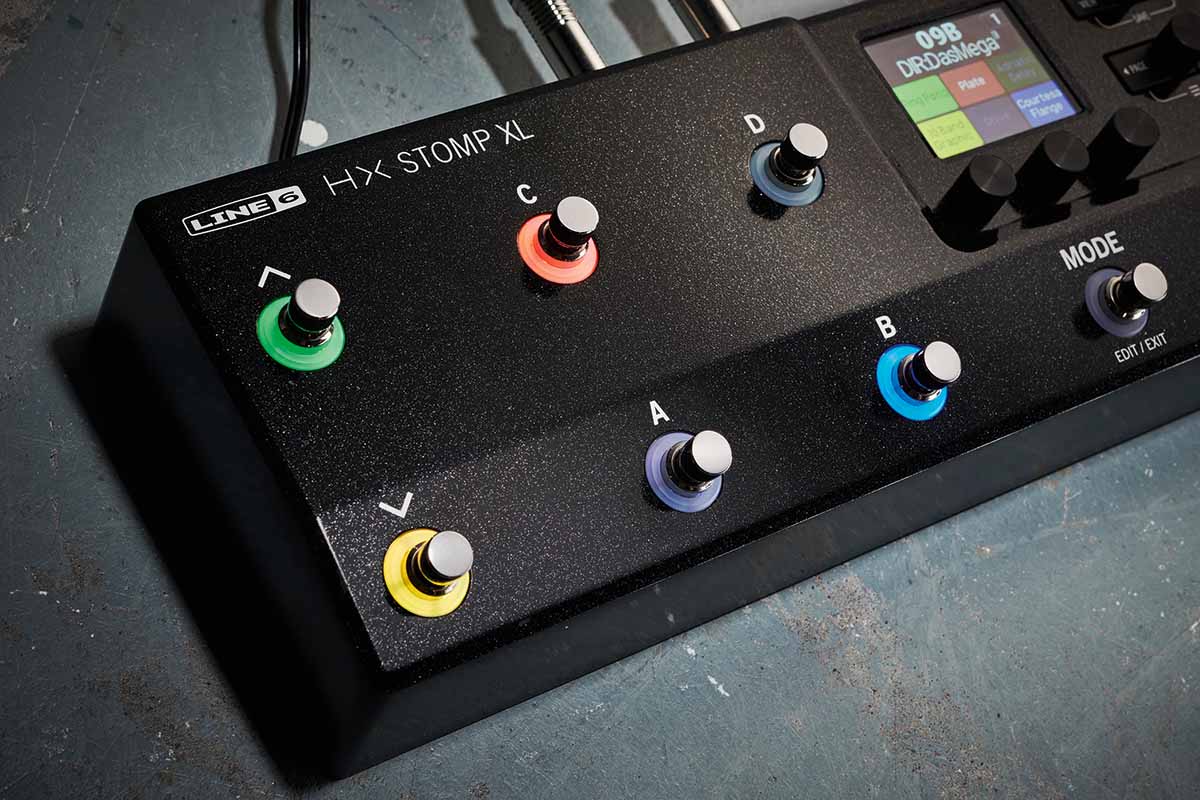Guitar World Verdict
Striking a balance between the full-sized Helix and Stomp models, Line 6's ever-impressive Helix format is even more approachable with the XL Stomp, with the extra footswitches making it a flexible, supremely powerful floorboard option that's pedalboard-friendly.
Pros
- +
Helix sounds without buying a Helix.
- +
Workable size.
- +
Practical footswitching arrangement.
- +
Flexible connectivity options.
- +
Audio interface functionality.
- +
MIDI control.
Cons
- -
The pedal needs high current and the supplied adaptor is quite large if you’re considering pedalboard mounting.
You can trust Guitar World
Until now, the Line 6 HX Stomp has been the perfect fit for anybody who wants to buy into the Line 6 experience but doesn’t want a huge floorboard – or the price tag.
As a pedalboard-friendly multi-effects pedal unit with Helix sounds (all the same effects, amps, cabs and IR loading as the flagship processor), it also sports the same 24-bit/192kHz converters, analogue impedance circuits and guitar inputs with 123dB of dynamic range.
The HX Stomp is, however, lacking some of the more complex Helix sound-building combinations, something few would consider a drawback, considering it has a great range of sounds regardless and comes at a much cheaper price. Nevertheless, a compromise that could put off potential users is the fact the unit has just three footswitches.
While there are ways to make these footswitches work for you, the players who yearn for the flexibility offered by a larger number have had their prayers answered by the introduction of Line 6’s new XL version, which ups the footswitch count from three to eight.

In use
With a greater number of footswitches, the HX Stomp XL has obviously grown in width – so can it still be described as ’board-friendly? Well, yes, we’d say so: it’s a little over 130mm (five inches) wider than its smaller sibling, but is still less than the size of two Boss 500 series pedals side by side.
What’s more, that width difference isn’t quite what it seems, because the smaller HX Stomp had socketry on both sides as well as the rear, so any plugs into those side sockets would increase the footprint. By contrast, the XL puts all its sockets on the rear panel, meaning those side cheeks could easily butt up against other similarly equipped pedals on your ’board.
Something else that’s migrated to the back panel is the Volume knob, and it’s now spring-loaded. This means you can set your volume and push it back into the chassis, so it can’t be accidentally knocked during a gig. Granted, it’s probably a little bit harder to tweak the output volume now, but the nature of the pedal pretty much means it would be a set-and-forget control anyway.
All the latest guitar news, interviews, lessons, reviews, deals and more, direct to your inbox!
The XL has two more presets than the smaller unit, but, apart from those, it’s still the same set. What has changed, though, is that you now get four snapshots instead of three in a preset – a snapshot being a preset within a preset, which can have altered parameters, a different number of active blocks, or a combination of both. These come into play in Snapshot mode (entered by pressing the two up/down arrowed footswitches together) where they are instantly accessible.

In fact, the switching between different modes is really uncomplicated on the XL. The two main modes we’d most likely gravitate to for practical stage use are Preset and Stomp. In Preset mode, the four presets in a bank are mapped to footswitches A to D and you change banks by using the up/down footswitches.
When you’ve selected a preset, you can then simply hit the Mode footswitch to enter Stomp Mode where six blocks from the preset are assigned to the main array of six footswitches, all with colour-coded LED rings, mirrored in the ‘Play view’ display, which is divided into six coloured rectangles.
There are two other modes of note. One is a Looper mode, which assigns looper controls across six footswitches – flexibility that was previously only instantly available if you added external footswitches.
The other mode is Pedal Edit, which effectively offers hands-free adjustment of parameters using the footswitches. That may be useful for a quick tweak on stage, but the hands-on front-panel editing is already straightforward, helped along by block selection through brushing the cap of the relevant footswitch.

It is, though, based on the fairly small display – away from the stage it’s much more practical to access the computer-based HX Edit software via USB. There’s plenty of scope for assigning parameters for external control and the expression pedal/footswitch jack has options for connecting up to two devices if you use a Y-cable.
By default, the socket is set for a Mission SP1-L6H Line 6 Expression Pedal with a toe switch that toggles between EXP 1 (Wah/Pitch Wham) and EXP 2 (Volume/Pan). There’s also the possibility of using MIDI control, as any block or parameter can be assigned to an incoming CC message.

Sounds
Of course, all of the pedal’s facilities would mean very little if the sounds weren’t up to scratch, but there’s no danger there, as these pedigree sounds are already in use by many guitarists for live work and recording.
With up to eight blocks (DSP permitting) in a serial signal chain with parallel routing possibilities, and in excess of 300 models to fill them, including more than 80 amps, the unit is capable of a sonic flexibility to suit a wide range of music styles, whether you’re looking for a fully processed composite amp/cab/effects chain or want to set up presets as pedalboards that access a bunch of individual effects.
The 25 banks of factory-written presets reflect that flexibility, ranging from some simple straight-up ready-to-record amp/cab sounds, through ambitiously complex sonic constructs. Plenty to explore and maybe use as springboards for creating your own sounds if you don’t want to build presets from scratch.

Verdict
It’s a clever move by Line 6 to offer two alternatives to anyone who wants to add Helix sounds to their existing pedalboard. Or maybe they want to have it as the centrepiece of a new rig, or even as their sole source of effects – something that the XL is particularly suited for with six switchable effects instantly available.
Both also have that ‘fly rig’ capability for easy portability and direct connection to a PA, making great use of the amp and cab simulation. What’s more, both usefully lend themselves well to home recording and silent practice with very flexible USB audio capability, as well as dedicated headphone output.
The XL’s price tag might be around $149/£200 more than its smaller sibling – but for the increased onstage flexibility that’s on offer here with those extra footswitches, we reckon that’s money very well spent, especially if you have the space to accommodate it.
Specs
- PRICE: $749 / £599
- ORIGIN: China
- TYPE: Multi-effects pedal with amp/cabs and effects
- FEATURES: Selectable buffered or true bypass, 128 preset locations
- (32 banks of 4), 8 in/6 out audio interface, looper, tuner, MIDI, regular firmware updates
- MODELS: More than 300 effects and models from Helix, M-Series and legacy Line 6 products
- CONTROLS: Volume, 5x soft knobs, 4x buttons, 8x footswitches
- CONNECTIONS: Standard inputs (L/Mono, R), standard outputs (L/Mono, R), Stereo Send, Return/Aux In (L/Mono and R), Exp pedal, MIDI In, MIDI Out/Thru, standard stereo headphone output, USB
- POWER: Supplied 9VDC DC-3G adaptor 3000 mA
- DIMENSIONS: 316 (w) x 120 (d) x 68mm (h)
- CONTACT: Line 6
Trevor Curwen has played guitar for several decades – he's also mimed it on the UK's Top of the Pops. Much of his working life, though, has been spent behind the mixing desk, during which time he has built up a solid collection of the guitars, amps and pedals needed to cover just about any studio session. He writes pedal reviews for Guitarist and has contributed to Total Guitar, MusicRadar and Future Music among others.


